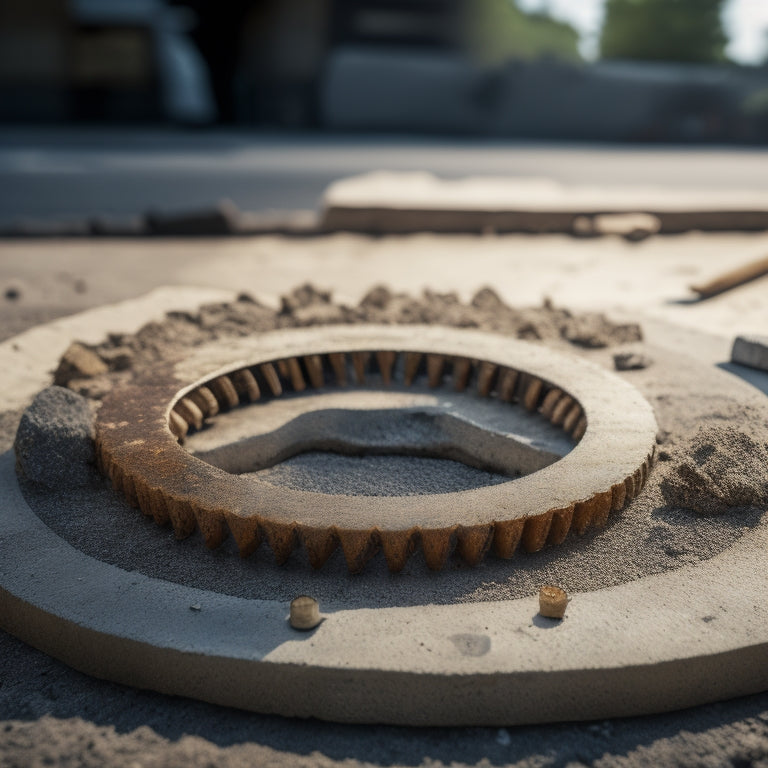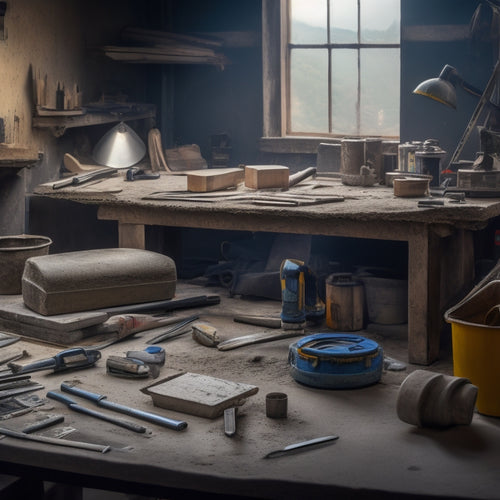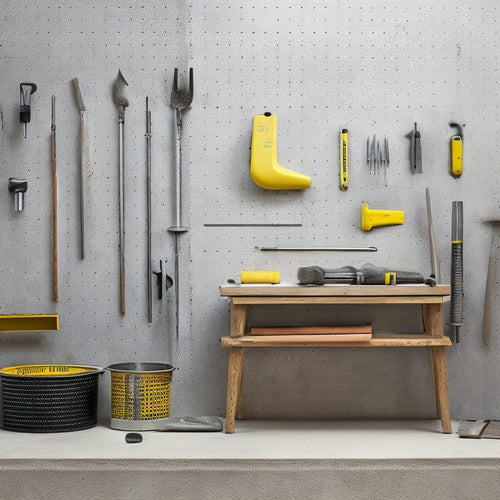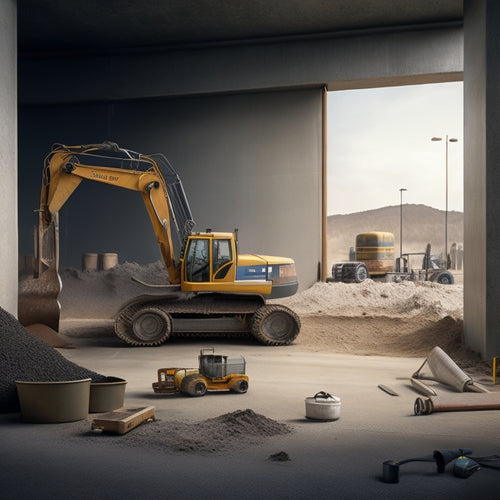
Why Second-Hand Concrete Cutting Tools Need Caution
Share
You're likely unaware that second-hand concrete cutting tools can harbor hidden dangers, from concealed damage to compromised performance, which can not only affect the quality of your work but also put your safety at risk. When purchasing second-hand tools, it's vital to inspect them thoroughly for signs of wear and tear, hidden damage, and authenticity. Be wary of suspiciously low prices, and verify the manufacturer's reputation. Proper maintenance, storage, and testing before use are also fundamental to guarantee peak performance and safety. By understanding the potential pitfalls, you'll be better equipped to make an informed decision and avoid costly mistakes - and there's more to investigate on this significant topic.
Key Takeaways
- Inspect second-hand concrete cutting tools thoroughly for signs of wear, damage, or neglect to avoid potential safety risks and performance issues.
- Verify the original manufacturer and warranty status to ensure authenticity and protection against defects.
- Be wary of suspiciously low prices, as they may indicate hidden damage or poor maintenance that can compromise tool performance and safety.
- Regular maintenance and cleaning are crucial to extend the tool's lifespan and prevent corrosion, dust buildup, and other issues.
- Testing tools before use is essential to identify any performance issues, ensure proper calibration, and prevent accidents or project delays.
Inspect Tools Before Purchase
When evaluating second-hand concrete cutting tools, inspecting them before purchase is essential to ensuring you get a good deal. You need to know what you're getting into, and a thorough inspection can reveal a lot about the tool's history.
Check the tool's documentation, such as maintenance records and repair history, to get an idea of its past use. This will help you determine its resale value and potential longevity.
Look for signs of wear and tear, like rust or corrosion, and check the condition of moving parts, such as blades or bearings. Are they worn out or still in good shape? Are there any missing or damaged components?
Take note of any modifications or customizations made to the tool, as these can affect its performance and value. By inspecting the tool thoroughly, you can make an informed decision and avoid buying a lemon.
A little diligence upfront can save you time, money, and frustration in the long run.
Check for Hidden Damage
When inspecting second-hand concrete cutting tools, you'll want to check for hidden damage that can impact their performance and safety.
Look for cracked tool handles, which can compromise your grip and control, and worn-out blade edges, which can reduce cutting efficiency and lead to accidents.
Cracked Tool Handles
Cracked tool handles can be a major concern when inspecting second-hand concrete cutting tools. You may think that a hairline crack is insignificant, but it can lead to a catastrophic failure, compromising your safety and the tool's performance.
When examining the handle, look for any signs of cracks, dents, or worn-out grips. Check if the material quality is up to par, guaranteeing it meets the required safety standards.
A cracked handle can be a breeding ground for further damage. Moisture can seep into the crack, causing corrosion or weakening the material. This can lead to a sudden break, leaving you with a useless tool and potentially injuring you or others nearby.
Be cautious when inspecting the handle, and don't hesitate to reject the tool if you find any damage. Remember, your safety is paramount, and a cracked handle is a significant red flag.
Always prioritize tools with handles made from high-quality materials that meet stringent safety standards to guarantee a safe and efficient working experience.
Worn-Out Blade Edges
Inspecting the blade edges of second-hand concrete cutting tools is just as essential as examining the handles.
When you're checking the blades, you're not just looking for visible damage, but also hidden signs of wear that can affect the tool's performance and your safety. Worn-out blade edges can lead to reduced blade longevity, compromising your ability to complete tasks efficiently.
Here are some key things to look out for:
-
Chipped or cracked blades: Even minor damage can weaken the blade's structure, making it prone to further damage or breakage.
-
Dull or rounded edges: Blunt blades can cause the tool to vibrate excessively, leading to loss of control and potential accidents.
-
Rust or corrosion: If the blade is rusty or corroded, it may be a sign of poor maintenance or exposure to harsh environments, which can affect its overall performance.
-
Inconsistent blade wear: Uneven wear patterns can indicate improper use or maintenance, which can compromise the tool's safety standards.
-
Worn-out blade segments: If individual segments of the blade are worn down, it may be a sign of excessive use or poor maintenance, requiring immediate attention.
Verify Original Manufacturer
Your toolset's credibility hinges on the authenticity of its components, and verifying the original manufacturer is a vital step in confirming you're getting a genuine product.
When purchasing second-hand concrete cutting tools, it's essential to research the manufacturer's reputation and warranty verification. A reputable manufacturer stands behind their product, offering warranties that cover defects and performance issues.
Verify the manufacturer's warranty by checking the product's documentation, website, or contacting their customer support. Be cautious of manufacturers with poor reputations or those that don't offer warranties.
A genuine product from a reputable manufacturer guarantees you're getting a high-quality tool that meets industry standards. Additionally, a warranty provides protection against defects and performance issues, giving you peace of mind and saving you from costly repairs or replacements.
Be Wary of Low Prices
Several second-hand concrete cutting tools on the market boast suspiciously low prices, which should raise red flags for buyers. You might be tempted by the promise of significant savings, but it's crucial to exercise caution when evaluating these deals.
When conducting a value assessment, consider the following factors that may contribute to suspiciously low pricing:
-
The tool's condition: Has it been properly maintained, or are there signs of wear and tear?
-
The seller's reputation: Are they a reputable dealer, or is this a one-time sale?
-
The tool's age: Is it an outdated model, or is it still supported by the manufacturer?
-
The warranty: Is it still valid, or has it expired?
-
Pricing trends: Are similar tools selling for comparable prices, or is this an anomaly?
Understand Tool Maintenance
You'll extend the life of your second-hand concrete cutting tools by prioritizing regular inspection, proper storage, and cleanliness.
These habits help prevent damage, reduce wear and tear, and maintain peak performance.
Regular Inspection Needed
Regularly, concrete cutting tools are subjected to harsh conditions, which can lead to wear and tear, compromising their performance and potentially causing accidents.
As you use second-hand concrete cutting tools, it's important to prioritize regular inspection to verify they meet safety standards and maintain their tool lifespan.
You should inspect your tools frequently, looking for signs of damage or wear. This includes:
- Checking for cracks or damage to the blade or cutting edge
- Inspecting the tool's electrical components for signs of wear or damage
- Verifying that all moving parts are functioning smoothly and without resistance
- Confirming that the tool's handle or grip is secure and comfortable to hold
- Checking the tool's cord or hose for signs of damage or wear
Proper Storage Matters
Precision is key when it comes to storing second-hand concrete cutting tools, as improper storage can lead to damage, rust, or corrosion, ultimately affecting their performance and lifespan.
You need to guarantee that your tools are stored in a dry, clean environment with controlled humidity levels. This will prevent moisture from accumulating and causing damage to the tools.
Temperature regulation is also essential, as extreme temperatures can cause materials to expand or contract, leading to warping or cracking. Ideally, you should store your tools in a room with a consistent temperature between 60°F and 80°F (15°C and 27°C).
Avoid storing tools in areas prone to flooding or water damage, such as basements or outdoor sheds.
When storing your tools, make sure they're clean and dry before putting them away. You should also consider using protective covers or cases to shield them from dust and debris.
Cleanliness Is Key
When it comes to maintaining your second-hand concrete cutting tools, cleanliness is essential to their longevity and performance. You can't afford to neglect tool hygiene, as it directly affects the tool's ability to cut through concrete efficiently and safely.
Dust management is also vital, as concrete dust can clog the tool's air vents and damage its internal components.
To guarantee your tools remain in top condition, follow these cleaning and maintenance tips:
- Regularly brush off concrete dust and debris from the tool's exterior using a soft-bristled brush or cloth.
- Use a gentle cleaning solution and a soft-bristled brush to remove stubborn concrete residue from the tool's cutting edges and surfaces.
- Dry the tool thoroughly after cleaning to prevent rust and corrosion.
- Lubricate moving parts regularly to prevent wear and tear.
- Store your tools in a clean, dry environment to prevent dust and moisture accumulation.
Look for Proper Storage
Organization is key to extending the life of your second-hand concrete cutting tools. When it comes to storage, you can't just throw them in a corner or bin. You need to implement proper storage techniques to prevent damage, rust, and corrosion.
This means dedicating a specific area for tool organization, where each tool has its designated place. Use toolboxes, cabinets, or shelves with dividers to keep similar tools together and prevent scratching or tangling.
Label each compartment or section, so you can quickly identify where a specific tool is stored. This will also help you maintain an inventory of your tools and identify what needs to be replaced or repaired.
Store tools in a dry, cool area away from direct sunlight and moisture. Clean and dry tools before storing them to prevent rust and corrosion.
Check for Recalibration Needs
Your second-hand concrete cutting tools have likely been used extensively before they reached your hands, which means their calibration may be off. This can lead to inaccurate cuts, reduced tool life, and even safety hazards.
To guarantee you get the most out of your tools, it's crucial to check for recalibration needs.
When checking for recalibration needs, consider the following factors:
-
Usage history: If the previous owner didn't maintain a consistent recalibration frequency, the tool may require immediate recalibration.
-
Tool type: Different tools, such as diamond blades or core drills, require specific recalibration techniques.
-
Visible signs of wear: Look for signs of wear on the tool's cutting edges or guides, which can indicate the need for recalibration.
-
Performance issues: If the tool is producing uneven cuts or vibrations, it may be due to a calibration issue.
-
Manufacturer's guidelines: Check the manufacturer's recommendations for recalibration frequency and techniques to ensure you're following best practices.
Test Tools Before Use
Before putting your second-hand concrete cutting tools to work, thoroughly test them to confirm they're functioning as expected. You don't want to compromise your project's quality or put yourself at risk due to subpar tool performance. Testing guarantees you identify any issues beforehand, allowing you to address them promptly.
When testing, pay attention to the tool's speed, vibration, and overall operation. Check for any unusual noises, excessive heat generation, or uneven cutting patterns. These signs can indicate worn-out or damaged components that need replacement or repair.
A thorough test also helps you refine your user experience. You'll get a feel for the tool's ergonomics, balance, and handling, allowing you to make adjustments for peak comfort and control.
Frequently Asked Questions
Can Second-Hand Concrete Cutting Tools Be Refurbished or Remanufactured?
You can breathe new life into second-hand concrete cutting tools through refurbishment techniques, but you'll need to assess their condition carefully to guarantee restored tool performance meets your expectations, and that's where expert remanufacturing comes in.
How Do I Determine the Tool's Original Purchase Date and History?
You're excited to score a great deal on a used concrete cutter, but don't get too thrilled - you'll need to dig up its past! Inspect the tool for signs of wear, and request maintenance records to determine its original purchase date and history.
Are All Second-Hand Tools Automatically Considered Low-Quality?
You shouldn't assume all second-hand tools are low-quality; instead, research the brand's reputation and evaluate the tool's performance, as a reputable brand and well-maintained tool can still offer reliable results, even if it's not new.
Can I Negotiate the Price of a Used Concrete Cutting Tool?
When buying a used car, you wouldn't settle for the sticker price, would you? Similarly, you can negotiate the price of a used concrete cutting tool; research the market value, inspect the tool's condition, and make a reasonable offer to get the best deal.
Are Manufacturer Warranties Transferable to Second-Hand Buyers?
You'll find that manufacturer warranties may not transfer to you as a second-hand buyer, often due to warranty limitations, and it's your responsibility to verify the warranty's status and understand the terms before making a purchase.
Conclusion
When buying second-hand concrete cutting tools, it's essential to exercise caution. You've inspected the tools, checked for hidden damage, and verified the original manufacturer. You've also been wary of low prices, understood tool maintenance, looked for proper storage, and checked for recalibration needs. Now, test the tools before use to ascertain they're in good condition. According to the Concrete Sawing and Drilling Association, 75% of tool failures occur due to improper maintenance. By being diligent, you'll avoid costly repairs and guarantee a safe working environment.
Related Posts
-

3 Best Hand Tools for DIY Concrete Construction
When tackling a DIY concrete construction project, you'll need three essential hand tools to achieve a professional-l...
-

10 Must-Have Tools for Concrete Repair Organization
You'll need a solid organization system to keep your concrete repair tools and materials within easy reach, protected...
-

Why You Need Affordable Concrete Wall Construction Tools
You need affordable concrete wall construction tools to guarantee a profitable project, as the cost of equipment can ...


